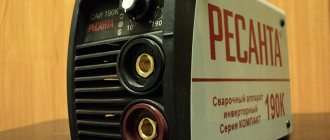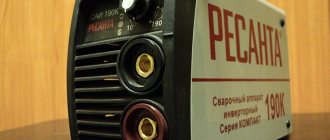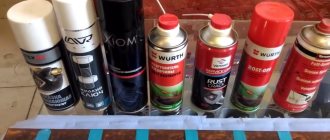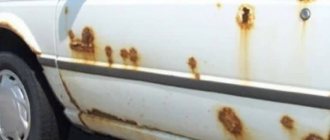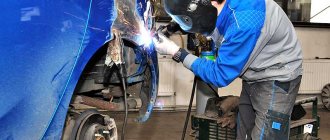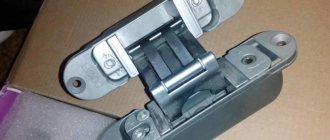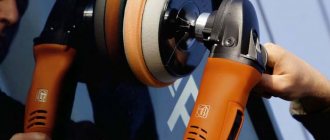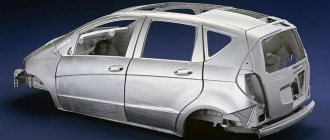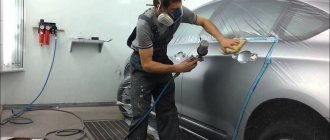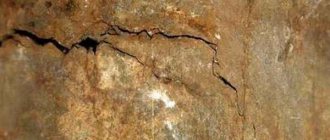Author: Evgeny Zhivoglyadov. Date of publication: April 19, 2016. Category: Automotive equipment.
The supporting element of each car is, of course, the body and its bottom, which serves as the so-called platform on which the main elements of the car are located. That is why, when purchasing a used car, the buyer first of all pays attention to the bottom, since if it is in a deplorable condition, then there is no point in spending effort on repairing it.
Thanks to modern technologies and the latest developments, today cars come off the assembly line with reinforced bodies, which are covered with special materials, such as fiberglass or polymers. Unfortunately, such treatment cannot yet be found on all cars, especially for domestic models, the body of which is made of ordinary metal, which is susceptible to the harmful effects of corrosion. But, even if you own a foreign car, this does not mean that at some point you will not find yourself with a “bare bottom”. The fact is that some manufacturers, in an effort to reduce the cost of a car, prefer not to spend money on additional processing; as a result, consumers get a “pig in a poke.”
Corrosion progresses quickly and can affect the most important and expensive elements of the car in a matter of months, which, in turn, will affect the operation of the chassis, suspension and other elements. If you carry out diagnostics and treatment in a specialized car service at least once a year, then there is nothing to worry about, but if you prefer to do everything yourself, then be sure to carefully check all possible places where rust occurs.
1) Preliminary inspection is necessary to make anticorrosive with your own hands
All vehicles must be inspected for corrosion.
Anti-corrosion materials can be applied to body parts where there are small pockets of corrosion, but not to layer rust or dense deposits of corrosion products several millimeters thick. Pay attention to particularly sensitive areas:
- around the headlight holes;
- door supports;
- door projections;
- door pockets;
- around the fuel tank;
- bending the lower part of the wheel arches;
- door sills;
- wings;
- luggage compartment;
- hood and engine compartment;
- suspension parts.
Also, pay due attention to narrow slots, corners, joints, welds, places of mechanical fastening of parts, parts closed with seals or moldings. If there are significant deposits of rust, it must be removed mechanically, accordingly, after which a conclusion can be made about what compositions to use for the work or recommend that the client, before carrying out work to protect the vehicle from corrosion, visit a body repair shop. The best solution is not to accept a vehicle in critical condition for processing.
The fact that a car is new, fresh from the showroom or with minimal mileage does not guarantee the absence of corrosion. The corrosion process often depends both on time and storage conditions, and on mileage, since mechanical damage during operation renders protective coatings unusable.
Causes of corrosion damage
Drivers should understand that externally treating doors with anti-corrosion agents will be useless if rust destroys the metal from the inside. The cavity, which is located under the casing, serves as a pocket for the side glass, laid cables, sensor units, etc. must be protected from corrosion as thoroughly as the visible part of the door. Causes of corrosion:
- poor anti-corrosion treatment of metal;
- electrochemical process;
- systematic contact with water;
- anti-ice reagents.
If the metal is rotten by more than 40%, there are large holes through it, then it is cheaper to replace the door.
Anti-corrosion treatment involves not just coating the doors with bitumen mastic or liquid paraffin, but also inspecting the metal first. If there are already traces of rust on the door, then the use of a preservative that stops the spread of corrosion will not be sufficient. It is necessary to clean the damaged area, prime it, and protect it with anticorrosive.
Electrochemical corrosion occurs at welding sites because the integrity of the metal is damaged at the points of contact between the aluminum patches and the steel.
If the drainage holes in the threshold are clogged, then there is always moisture inside the door, which contributes to the oxidation of the metal and rapid rotting. At the same time as the door, the thresholds begin to collapse, water gets into the cracks between the lining seals, penetrates into the inner frame, and destroys the body from the inside.
In winter, city streets are sprinkled with a salt composition so that the ice does not freeze in blocks and makes it easier to remove. Salts and aggressive chemicals, getting on the paintwork of the body and remaining in the cracks, destroy parts much faster than water. This is facilitated by the presence of scratches, chips, dents with damage to the paintwork.
3) Dismantling removable parts and plugs
To provide access to some areas of the body, it may be necessary to dismantle some trim elements and plugs for technological holes. In addition, sometimes this is done to avoid damage or contamination of interior parts (for example, carpets, trunk upholstery). One rule should be followed: if you cannot treat the area behind a removable part using a special spray tool, dismantle it. The fender liners and mudguards must be removed, because... Dirt and moisture accumulate under the surfaces adjacent to the wheel arches. The wheels also need to be removed, because... they make it difficult for cleaning to access arch surfaces that are complex in design, and in the future will make it difficult to apply a uniform layer of anti-corrosion compound. It’s easy to make anti-corrosion protection yourself if you have an idea about the structure of the car.
Preliminary surface preparation
Complete removal of old or factory paint is not considered mandatory, but a process such as stripping the underbody of a car must be carried out to the highest possible quality. It is imperative to remove all pockets of corrosion, since otherwise they will continue their destructive effect even after the underbody of the car is painted.
The vehicle is washed very carefully and then placed on a special lift above the inspection ditch. If possible, the wheels should be removed. The surface of the underbody of the car is dried in a special way and also sanded. For this purpose, special combinations with special iron brushes are used. Almost every element of the car must be processed separately, only then the underbody of the car is painted.
Even with a relatively superficial polish, the underside of the vehicle still needs quite a bit of work. Close attention is paid to thoroughly cleaning the surface from destructive corrosion. Precisely for the reason that the bottom is subjected to particularly stringent testing with crushed stone, moisture and dirt, the process of painting the bottom directly implies effective protection of the surface precisely from these destructive factors.
4) Car wash (Vehicle)
Surface cleanliness plays an important role in anti-corrosion treatment. Different vehicles require washing depending on their condition. For example, new cars usually only need to be washed with cold water under pressure. Used cars require hot water (approximately 70 degrees Celsius) pressure washing. However, sometimes new cars have oily or dirty undersides and wheel arches. In this case, a thorough hot water pressure wash is also necessary. Washing the bottom (necessary to make an anti-corrosion bottom) should be done on a lift; if there is no lift, it is permissible to use a trestle or rolling lifting mechanisms that could provide a good approach to the bottom and arches of the vehicle. If you decide to do the anticorrosive yourself, think about the location in advance.
Methods for removing rust
Cleaning the underbody of a car from corrosion is carried out in two ways:
- in anti-corrosion centers - where they will quickly and efficiently carry out a complete anti-corrosion treatment of the car;
- Do the bottom treatment yourself, which will help significantly reduce costs, but it will require time and effort.
When choosing an anti-corrosion center, you should talk to the receiver and evaluate his competence and professionalism in order to be confident in the quality of the services provided.
5) Drying
Each vehicle must be dried before anti-corrosion materials are applied. After washing with a high-pressure apparatus, the car dries unevenly, water may remain in the cavities, while the underbody will already be dry. Cavity materials can be applied to wet surfaces, but not to “puddles” of water.
Drying the surface with an air gun is not recommended. Drying should be done with intense air movement or with the help of natural ventilation outside in warm weather if you are going to make anti-corrosive paint with your own hands without a specialized room.
If, during the evaporation of a substance, the evaporated molecules are not removed from the surface of the liquid, a moment comes when the number of molecules that have passed from the liquid to the gaseous state is equal to the number of molecules that make the reverse transition from gas to liquid. They say that the point of saturation has arrived and under these conditions no further evaporation occurs.
The moment at which saturation occurs depends on several factors, for example, the type of liquid, temperature, etc. In the case of water and white spirit, this time is very short (on the order of a few milliseconds).
When the moment of saturation arrives, evaporation does not occur and the liquid remains where it was. The only way to cause evaporation again is to remove the evaporated molecules from the surface of the liquid. The easiest way to do this is to ensure the movement of dry air along the surface.
An increase in air temperature leads to an increase in the number of molecules passing from liquid to gas, but the moment of saturation will still occur if the evaporated molecules do not move away from the surface. At the moment of saturation at elevated temperatures, the number of molecules passing from the liquid to the gaseous state and back will still be equal, but their total number will be greater, the higher the temperature.
Thus, increasing the temperature and intensively blowing dry air onto the surface increases the drying efficiency.
COMMENT:
Although cavity sealants have moisture-displacing properties, they cannot displace large volumes of water.
Almost all manufacturers use anti-corrosion treatment to one degree or another. If we assume that the factory treatment always meets high standards, the coatings are free of defects, and all critical areas are protected, then we can safely refuse any additional treatment, at least during the initial period of operation of the car.
However, experience, supported by independent research, suggests that almost every treatment has defects. The most common problems encountered are:
Features of material selection
To effectively protect the underbody of a car, a large number of different materials are used, more than half of which are paints. Among the various primers with an anti-corrosion effect, the following compositions can be distinguished:
- Epoxy primer, which is able to set sufficiently high adhesion parameters, and also has durability indicators;
- Lead plumbate or special red lead, which provides optimal protection against moisture and various mechanical damages;
- Special liquid, cold zinc is used, which can replace factory galvanization;
- Liquid plastic, as well as special corrosion-resistant mastics. In terms of their level of protection, they are a little like soil, but with sufficiently strong vibration they can peel off;
- Anti-gravel compounds, which in their properties are a little similar to rubber. In addition, they effectively correct the special shock-absorbing properties inherent in metal;
- Special gun oil can provide optimal protection. It is recommended to use it only in certain areas, since it wears off with constant mechanical impact;
- Over relatively mild corrosion, you can use a special one.
The choice of one material or another directly depends on the characteristics and general condition of the underbody of the car.
Anticorrosive bottom:
A. Areas covered with masking tape. These are areas such as suspension mounting parts, brake system, etc. In some cases, the masking tape remains on the body, in others it is removed, leaving bare areas.
B. Areas missed during processing. For example, wheel arch flanges are almost never treated, although this is a favorite target for corrosion. At the factory, the easily accessible areas, such as the middle part of the bottom, are generally well treated, while corrosion primarily affects the perimeter of the bottom.
C. Uneven coverage. In some areas there are only traces of coating, while in others the layer is several times thicker than necessary.
D. Due to the peculiarities of the technology - for example, high-temperature drying of the body - swellings (bubbles) are formed on the underbody coating, some of which are from 1 to 10 cm in diameter. In addition, there are many smaller bubbles that appear when air penetrates into the coating during the drying process.
E. Most manufacturers use systems based on PVC plastisols to protect the bottom. PVC-based coatings tend to crack when exposed to sudden temperature changes.
Types of anticorrosives
The modern market offers hundreds of products for treating metal body parts against premature corrosion. Various classes of anticorrosives are used for internal and external surfaces. Compositions for internal bottom pockets, side members, and struts displace moisture from a closed cavity and have a high elasticity index. The materials do not harden and cover the inner surface with a protective film. Treatment is carried out using a pneumatic gun, if the product is in a jar, or with an aerosol can, the anticorrosive agent is poured into the cavity through a technical hole. The main components in the production of such protection remain paraffin, oil, and silicone. Anti-corrosion agents for external body treatment: the bottom, wheel arches, the outer part of the threshold have a dense composition, the material used is bitumen mastic, rubber base, organic and synthetic resins. The composition creates a dense elastic film with a thickness of 1 cm, which prevents the penetration of salt reagents, protects the bottom and sills from mechanical damage from flying gravel during movement.
Anticorrosive treatment of hidden cavities:
A. Overlooked Areas - While the areas most susceptible to corrosion should be protected, in most cases these are the areas that remain untreated.
B. Uneven coating thickness
C. Covered Areas - Due to the use of inappropriate spray tools, some areas in body cavities are obscured by internal components (such as ribs and reinforcements). The composition does not reach these areas and they remain unprotected.
D. It is not possible to carry out a complete high-quality anti-corrosion treatment of a vehicle at the production stage, since this is a long and expensive process.
Carrying out rust removal work
Anti-corrosion cleaning of the underbody of the car should be carried out only after washing, since this way you can see all the problem areas. After drying the body, you should begin examining the surface to identify pockets of rust or swollen paint.
The next stage of work is to clean the affected area. Cleaning time directly depends on the method used to remove the old layer of mastic. So, the most time-consuming and tedious method is cleaning with a wire brush or sandpaper. Using a grinding machine, you can prepare the surface for further work much faster.
Important: you need to clean the area 3-4 cm around the rust stain until a smooth and even surface appears.
After the cleaning work is completed, you need to treat the problem area with a degreasing solution and apply a rust converter. Its main task is to transform the rust remaining on the bottom into soil. It is applied using a regular rag. After waiting for the corrosion converter to dry, you can apply a new layer of anti-corrosion coating.
Additional anti-corrosion protection for the underbody and body:
Due to corrosion, the strength of vehicle frames and body parts in places of welds and mechanical fastenings is compromised. According to the IIHS (American Insurance Institute for Highway Safety), the crash test results of cars that have not undergone anti-corrosion treatment are halved after 3-5 years.
The client comes for additional anti-corrosion treatment in order to insure his car against possible corrosion problems. And this is exactly what we must offer him - to detect and eliminate potential threats with the help of competent and professional processing. Based on this, the first anti-corrosion treatment operation should be a thorough inspection of the condition of the body. In this case, you should pay attention to the following points:
- There is no need to remove the factory coating.
- If there is masking paper, it must be removed.
- If there are peelings of the coating, remove the peeled areas using a sharp tool without damaging the coating with good adhesion.
- If there are pockets of loose rust, it must be removed with a wire brush.
Properties of anti-corrosion coating
Any anti-corrosion coating must have the following important qualities:
- abrasion resistance – the ability to protect car parts from regular exposure to abrasives;
- environmental friendliness - rust removal products must be environmentally friendly;
- frost resistance - the product must retain all its properties even at low temperatures;
- high activity - the drug must be well saturated to stop corrosion;
- plasticity - since constant vibrations and deformations are possible during movement;
- the material must be retained on the surface of the car at high temperatures.
Anticorrosive treatment. Quality criteria:
As is known, all protective coatings have their own critical thickness, below which long-term protective properties decrease. The physical characteristics of the materials and equipment must ensure that the required thickness of the coating is applied.
The complexity of the body structure with an abundance of hidden cavities requires anti-corrosion materials to have special properties such as penetrating ability and moisture displacement. So, the protective properties of the coating are ensured by applying a film layer of at least a critical thickness.
Penetrating ability is ensured by the penetration of the material into micro-gaps to an effective depth and height in the required quantity. The moisture-displacing ability is ensured by the distribution of the film over the entire area of the wet surface.
All cavities are treated from the outside through small technological openings using spray nozzles in the absence of visual control. Consequently, the equipment and fixtures used must guarantee the application of anti-corrosion compounds within the normal film thickness and in the proper volume. Good command of the spraying technique combined with knowledge of the structure of the hidden cavities of the body is a mandatory requirement for a specialist in anti-corrosion treatment; pay attention to this point if you decide to do the anti-corrosion treatment yourself.
Make anticorrosive with your own hands. Features of materials:
Professional anti-corrosion compounds must have good thixotropy (the ability to remain in a horizontal position), i.e. After applying the coating to the surface, the film thickness should not decrease below a critical level due to runoff, dripping under the influence of temperature or vibration.
It is a fallacy to say that a material should not change its initial properties over time. According to the laws of physics and chemistry, this is impossible; changes inevitably occur. The best materials are distinguished by the fact that their protective properties change slowly and evenly. Thus, periodic renewal of the protective coating and additional anti-corrosive treatment are necessary.
The car body has hidden cavities of various configurations and sizes, located in different places. Accordingly, these cavities have different microclimates - humidity, temperature, electrolyte concentration. Some areas of the body, due to their aggressive microclimate, are more susceptible to corrosion. Such areas are called critical. Examples of such areas are cavities with an abundance of microgaps and welds. The lower they are located and the closer to the engine compartment, the higher the corrosion rate.
This happens for the following reasons:
- in microgaps the electrolyte lasts longer than in open areas;
- water from the road constantly gets onto the lower part of the body;
- areas near the engine compartment become hot.
Another example is box sections designed without regard to corrosion resistance requirements. Such sections retain water and are exposed to high humidity for a long time, and in winter they are subject to the forces of freezing water increasing in volume.
Thus, effective protection is ensured by paying special attention to critical areas. The mere presence of anti-corrosion material in hidden cavities is not enough for a high rating of vehicle treatment. In order to evaluate the quality of processing, it is necessary to ensure that the material is present in critical areas, and that the film thickness and volume of the composition will provide reliable protection for the longest possible period of operation.
Noteworthy anticorrosive brands
To reliably treat the bottom of your vehicle from emerging pockets of rust, you need a high-quality anti-corrosive agent. Below we list the main brands from well-known manufacturers.
Manufactured on a wax basis
The most popular are the following:
- TURBO is a highly effective anti-corrosion mastic that provides long-term protection of steel surfaces. It penetrates welds and seals surface defects. TURBO forms an elastic brown wax-like film, self-healing in case of destruction. It can also prevent existing corrosion and provide long-term protection to pre-corroded and non-corroded surfaces.
- WAXOYL - is applied and forms an elastic waterproof film. It helps prevent new rust and kills old rust, and is used on car interiors, inside doors, on sills and anywhere water collects. Does not crack, dry out or wear off.
Manufactured from rubber, polymer and bitumen
Quality brands:
- DINITROL is highly valued by consumers. Creates a protective barrier on the external surfaces of the car body. There is no unpleasant odor. Complete drying is not required. You can coat the surface with DINITROL mastic in areas that are free of rust.
- MERCASOL - protects the body and surfaces from rusting and maintains a protective barrier for a long time.
- TECTYL - has the ability to displace water so wet surfaces are protected, delays and prevents corrosion on rusty surfaces and provides self-healing ability if the protective barrier is damaged.
- BODY - forms a waxy layer, creates a barrier on the surface, has penetrating properties. The main disadvantage is considered to be rapid erasure.
THE MOST SUSPENDED AREAS OF THE CAR BODY
- Rear upper part of the engine compartment.
- The area where the wings meet the body and the areas around the headlights. This includes the cavities and adjacent areas of the inside of the wheel arches along with the flanges, seams and joints that extend into the engine compartment.
- Hood - amplifier cavities, area around the perimeter of the hood.
- Doors - the lower half of the door, edges, reinforcements and stiffeners, hinge fastenings.
- Wheel arches - seams, rear part of the arch up to half the radius, edges of the wings.
- Welded seams in the corners of the body.
- Box sections behind the rear bumper.
- Suspension mounts, side members, cross members, areas around the shock absorber strut mounts.
- The cavities in the thresholds corrode very intensively and, accordingly, require special attention during anti-corrosion treatment of the vehicle.
Processing diagram to make anticorrosive with your own hands
Preparing tools
If you remove rust from the bottom of a car with your own hands, then to carry out the work you need to purchase special materials and prepare tools:
- sanding machine or sandpaper;
- putty knife;
- blowtorch;
- mastic remover;
- metal brush or roller;
- degreaser;
- anti-corrosion primer;
- rust converter;
- putty;
- latex gloves;
- paper mounting tape.
Summary
In cases where a critical level of rust has formed in closed cavities, you need to Apply Movil with a rust converter. If the car is new, then any of the listed drugs will do.
In our harsh climatic conditions, the optimal coating for the bottom would be Body 930 plus Movil in glass containers or Tectyl Zinc BodySafe. The latter anticorrosive agent is preferable, but more expensive. Tectyl is also effective when working with internal cavities, but Movil is cheaper, which, moreover, can be found in aerosol cans with all kinds of additives.
